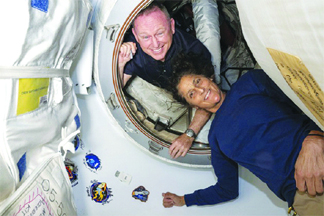NASA has decided that it’s too risky to bring two astronauts, including Indian-American Sunita Williams, back to Earth in Boeing’s troubled new capsule, and they’ll have to wait until next year for a ride home with SpaceX.
What should have been a week long test flight for the pair will now last more than eight months.
The seasoned pilots have been stuck at the International Space Station since the beginning of June. A cascade of vexing thruster failures and helium leaks in the new capsule marred their trip to the space station. They ended up in a holding pattern as engineers conducted tests and debated what to do about the trip back.
After almost three months, the decision finally came down from NASA’s highest ranks on Saturday. Butch Wilmore and Williams will come back in a SpaceX spacecraft in February. Their empty Starliner capsule will undock in early September and attempt to return on autopilot. As Starliner’s test pilots, the pair should have overseen this critical last leg of the journey, with a touchdown in the US desert.
“A test flight by nature is neither safe nor routine,” said NASA Administration Bill Nelson. “And so the decision … is a commitment to safety.” “This has not been an easy decision, but it is absolutely the right one,” added NASA Associate Administrator Jim Free.
It was a blow to Boeing, adding to the safety concerns plaguing the company on its airplane side. Boeing had counted on Starliner’s first crew trip to revive the troubled program after years of delays and ballooning costs. The company had insisted Starliner was safe based on all the recent thruster tests both in space and on the ground.
Boeing did not participate in Saturday’s news conference by NASA but released a statement, “Boeing continues to focus, first and foremost, on the safety of the crew and spacecraft. We are executing the mission as determined by NASA, and we are preparing the spacecraft for a safe and successful uncrewed return.” Source: AP
NASA to keep 2 astronauts in space until Feb, nixes return on troubled Boeing capsule
